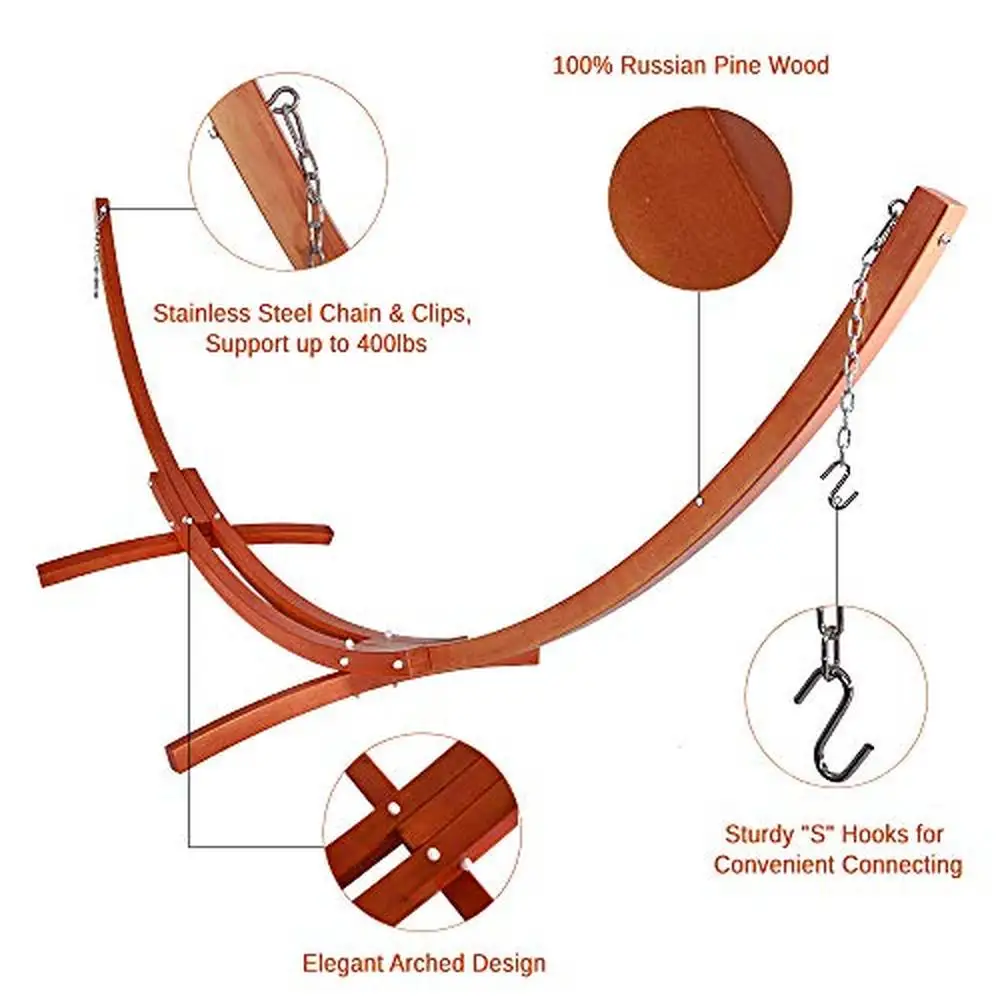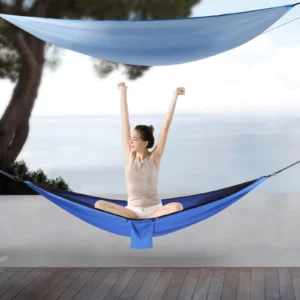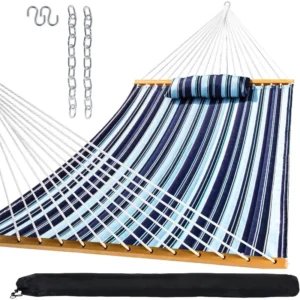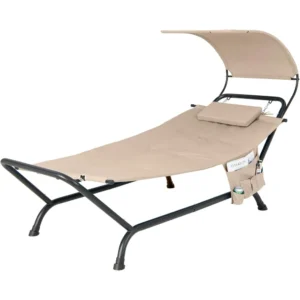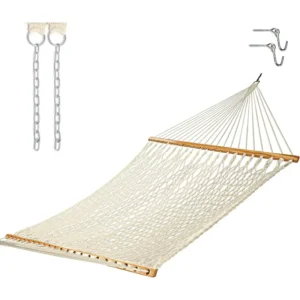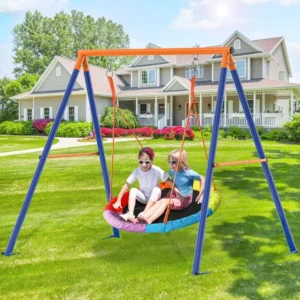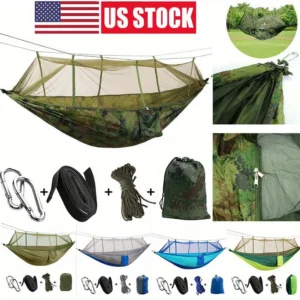Introduction: Key Differences Between Hammock Types
When it comes to selecting the perfect hammock for your relaxation needs, two main designs dominate the market: spreader bar hammocks and gathered end hammocks. While both offer a suspended lounging experience, they provide distinctly different comfort profiles and serve different purposes.
Spreader bar hammocks feature rigid bars at each end that spread the fabric wide, creating a flatter, more open surface. This design prevents the fabric from wrapping around you completely. In contrast, gathered end hammocks have fabric that bunches together at each end, creating a cocoon-like enclosure when you lie in them.
Choosing between these two styles depends on how and where you plan to use your hammock. Your indoor-outdoor hammock placement considerations will significantly influence which style better serves your needs. Outside Luxe offers premium options in both styles, with our spreader bar hammock sets featuring exceptional craftsmanship and materials.
Here’s a quick comparison to help you understand the key differences:
| Feature | Spreader Bar Hammocks | Gathered End Hammocks |
|---|---|---|
| Comfort Position | Flat, bed-like surface | Curved, cocoon-like wrap |
| Stability | Lower (higher center of gravity) | Higher (lower center of gravity) |
| Portability | Heavier, bulkier | Lightweight, compact |
| Weight Capacity | Typically 250-450 lbs | Typically 300-500 lbs |
| Setup Complexity | More complex, requires more space | Simple, adaptable to various spaces |
| Ideal Use Cases | Backyard, poolside, decorative | Camping, backpacking, travel |
| Price Range | Generally higher | Generally more affordable |
In this guide, we’ll explore these differences in depth to help you determine which hammock type best suits your needs, preferences, and lifestyle.
Understanding Spreader Bar Hammocks: Design & Features
Spreader bar hammocks represent a modernized take on the traditional hammock design. Their most distinctive feature is the wooden or metal bars at each end that keep the hammock fabric spread open, creating a flatter lying surface than their gathered end counterparts.
These hammocks typically have a rectangular shape, with the fabric suspended across the spreader bars. The bars themselves attach to chains or ropes that connect to the hanging points, creating tension that maintains the hammock’s shape even when unoccupied. Understanding how spreader bars affect hammock balance is crucial for safe and comfortable use.
Key features of spreader bar hammocks include:
- Material Options: Premium spreader bar hammocks use materials like:
- Textilene or Sunbrella fabric for outdoor durability and weather resistance
- Soft cotton for superior comfort in less exposed settings
Polyester blends that balance comfort and durability
Size and Dimensions: Typically 6-8 feet long × 4-5 feet wide, providing a spacious lounging surface
Design Variations: While most feature a classic lattice rope design, modern rope hammock sets can include quilted surfaces, padded options, and innovative hybrid designs
Attachment Methods: Usually hung using chains or ropes with hooks or S-hooks that attach to fixed points like trees, posts, or dedicated hammock stands
Distance Requirements: Generally require 10-15 feet between hanging points to achieve proper tension
The spreader bars create a more accessible surface that’s easier to get in and out of compared to gathered end designs. However, this same feature raises the center of gravity, making these hammocks more prone to tipping if weight isn’t properly distributed or if users enter them improperly.
Understanding Gathered End Hammocks: Design & Features
Gathered end hammocks represent the traditional hammock design that has been used for centuries across different cultures. Their defining characteristic is the way the fabric gathers to a point at each end, creating a natural curve when hung.
Unlike spreader bar hammocks, gathered end designs allow the fabric to wrap partially around the user, creating what enthusiasts call a “cocoon effect.” The fabric naturally forms a deep curve that cradles the body when properly hung with the right amount of slack.
Key features of gathered end hammocks include:
- Material Construction: These hammocks commonly use:
- Lightweight parachute nylon (often ripstop) for camping and backpacking
- Cotton or cotton blends for indoor use and comfort
Specialized synthetics for enhanced durability and weather resistance
Size and Dimensions: Typically longer than spreader bar designs (9-11 feet) with fabric width of 4-6 feet that gathers at the ends
Suspension System: Usually employ adjustable straps, whoopie slings, or rope systems that allow for variable hanging heights and distances
Diagonal Lay Capability: Designed to allow users to lie diagonally across the fabric for a flatter, more ergonomic position
Weight and Packability: Often fold or stuff into attached compression sacks about the size of a grapefruit
Our camping hammocks and stands collection showcases the versatility of gathered end designs, with options ranging from ultralight backpacking models to more robust versions suitable for regular outdoor use.
The gathered end design creates a lower center of gravity compared to spreader bar hammocks, contributing to their greater stability. This makes them particularly popular among campers and backpackers who need reliable sleep systems in various outdoor environments.
Comfort & Sleeping Position: Finding Your Perfect Lay
The comfort difference between spreader bar and gathered end hammocks largely comes down to how your body positions when lying in them and your personal sleeping preferences.
Spreader bar hammocks offer a flatter surface that more closely resembles a traditional bed. This design allows you to sleep in multiple positions—back, side, or even stomach—making them versatile for different sleeping styles. The open design also prevents the claustrophobic feeling some users experience in gathered designs.
Gathered end hammocks initially appear to force users into a curved “banana” position that can be uncomfortable for extended periods. However, experienced hammockers know the secret: the diagonal lay. By positioning yourself at an angle (approximately 30° from the centerline), you create a surprisingly flat surface area for your torso while your legs and head remain slightly elevated. This position often provides excellent support for the back and eliminates pressure points.
According to hammock community surveys, about 75% of overnight hammock sleepers prefer gathered end designs due to their stability and comfort when using the diagonal lay technique. However, approximately 65% of casual daytime users prefer the accessibility and traditional appearance of spreader bar designs.
Material selection significantly impacts comfort in both designs:
- In spreader bar hammocks, quilted fabrics or padded surfaces enhance comfort for longer lounging sessions
- In gathered end hammocks, the stretch and breathability of the fabric determine how well it conforms to the body
Proper hammock installation requirements and safety guidelines ensure maximum comfort regardless of the design you choose. The right hanging height, tension, and anchor point stability all contribute to the overall experience.

Stability & Safety: Which Type Is Less Likely to Flip?
When it comes to stability, gathered end hammocks have a clear advantage due to their fundamental design. The physics of these two hammock styles create very different stability profiles that directly impact safety and ease of use.
Spreader bar hammocks have an inherently higher center of gravity because the bars hold the fabric open and elevated. This creates a less forgiving balance point that can tip if:
– Weight is unevenly distributed toward one side
– Users enter or exit with too much lateral movement
– The hammock is hung too tightly, increasing instability
In contrast, gathered end hammocks feature:
– A natural “self-centering” design that cradles users
– A lower center of gravity that resists tipping
– More tolerance for movement when entering and exiting
To safely use a spreader bar hammock:
– Sit in the center before lying down
– Distribute weight evenly as you recline
– Move deliberately rather than quickly
– Keep your weight centered when adjusting positions
Gathered end hammocks require a different approach:
– Sit on the edge and pivot your legs in
– Use your hands to spread the fabric as you sit
– Recline gradually into the curve
Weight capacity differences are notable as well. While premium spreader bar hammocks typically support 250-450 lbs (113-204 kg), quality gathered end hammocks often accommodate 300-500 lbs (136-227 kg) due to their tension distribution mechanics.
For comprehensive guidance on safely enjoying either style, our indoor-outdoor hammock safety guide provides detailed recommendations for secure setup and use in various environments.
Portability & Setup: Travel-Friendly or Backyard Staple?
The portability difference between these hammock styles is substantial, making each better suited for different usage scenarios.
Gathered end hammocks excel in portability with impressive specifications:
– Typical weight: 1-4 lbs (0.45-1.8 kg)
– Packed dimensions: About the size of a grapefruit to a small loaf of bread
– Setup time: 2-5 minutes with proper suspension
– Required distance between anchor points: 10-15 feet (more flexible)
Spreader bar hammocks are considerably less portable:
– Typical weight: 8-15 lbs (3.6-6.8 kg)
– Packed dimensions: Bulky, non-compressible due to rigid components
– Setup time: 5-15 minutes depending on complexity and stand requirements
– Required distance between anchor points: 12-15 feet (less flexible)
This significant difference in portability makes gathered end hammocks the overwhelming choice for activities like:
– Backpacking and hiking
– Travel and camping
– Situations requiring frequent relocation
Our detailed portable fixed hammock comparison further explains how these differences impact real-world usage. For those seeking greater flexibility, our portable hammocks stands collection offers solutions that combine convenience with stability.
Spreader bar hammocks typically require dedicated spaces where they can remain set up, making them ideal for:
– Permanent backyard installations
– Deck and patio settings
– Poolside or beach house environments
The setup process also differs significantly. Gathered end hammocks utilize simple suspension systems (often tree straps with carabiners) that adapt to various distances and anchor points. Spreader bar hammocks usually require more precise distance measurements and often benefit from purpose-built stands rather than natural anchors like trees.
Durability & Weather Resistance: Built to Last
The durability profile of each hammock style varies based on both design and materials, with each excelling in different environmental conditions.
Spreader bar hammocks typically feature:
– Exposed fabric that receives more direct UV radiation
– Materials like Textilene or Sunbrella specifically engineered for outdoor durability
– Wooden or metal components that require periodic maintenance
– Greater vulnerability to mold/mildew if not properly dried after exposure to moisture
Gathered end hammocks offer different durability advantages:
– Ripstop nylon that resists tears and abrasions
– Simple construction with fewer potential failure points
– Materials that dry quickly after exposure to moisture
– Better resistance to repeated packing/unpacking cycles
For long-term outdoor installation, properly determining if it’s okay to leave your hammock outside depends on both the hammock type and specific materials. Premium outdoor-rated fabrics can withstand thousands of hours of UV exposure before significant degradation occurs.
Quality indicators for durable hammocks include:
– Double or triple stitching at stress points
– Higher fabric denier ratings (typically 70D-210D for gathered end, 600D+ for outdoor spreader bar fabric)
– Marine-grade hardware for spreader bar designs
– Weather-treated wood or aluminum components
Regardless of type, proper maintenance significantly extends hammock lifespan. This includes regular cleaning according to manufacturer guidelines, proper storage during extreme weather, and periodic inspection of all attachment points and suspension components.
Aesthetics & Design: Finding Your Style
The visual appeal of your hammock contributes significantly to the overall relaxation experience, and the two hammock styles offer distinctly different aesthetic statements.
Spreader bar hammocks provide a classic, resort-like appearance that:
– Creates a focal point in outdoor living spaces
– Offers a more traditional and recognizable hammock silhouette
– Showcases decorative rope work and craftsmanship
– Complements manicured backyard and garden settings
These hammocks often feature elegant lattice rope patterns, quilted surfaces with decorative stitching, or premium wooden spreader bars that enhance their visual appeal. Many users select these designs specifically for their ability to enhance outdoor spaces visually.
Gathered end hammocks present a more minimalist, functional aesthetic:
– Clean, simple lines when hung
– Contemporary technical appearance (especially in camping models)
– More subdued visual presence in the landscape
– Focus on performance over decorative elements
For enhanced visual impact, hammock sets with canopies create a complete relaxation zone with coordinated design elements. These systems combine comfortable hammocks with shade structures that both protect users from sun exposure and create a defined relaxation space within larger outdoor environments.
Color selection also plays a major role in hammock aesthetics. While spreader bar hammocks often feature classic whites, nautical blues, or rich earth tones, gathered end designs embrace both vibrant technical colors and subtle natural hues depending on their intended use environment.
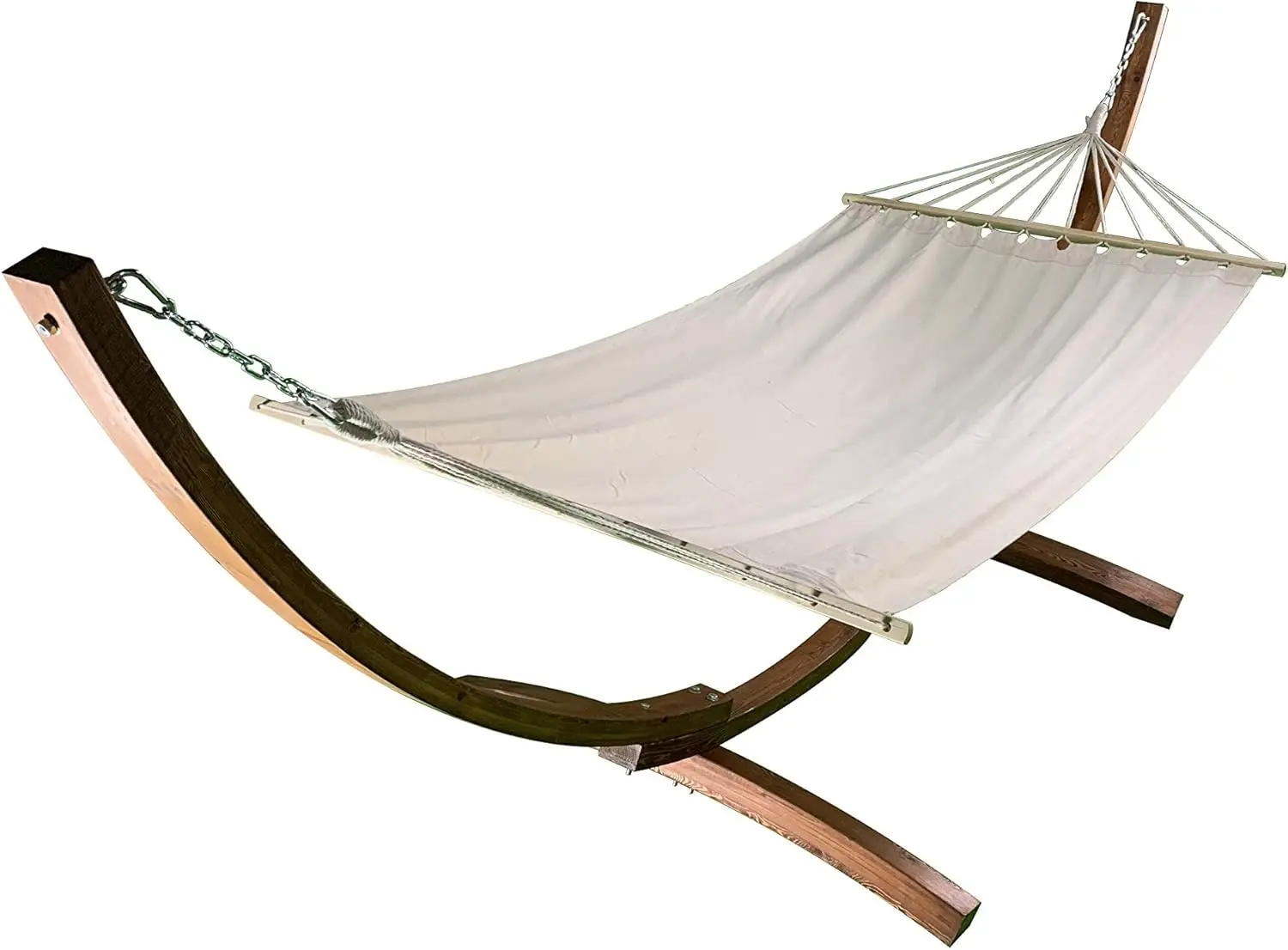
Temperature & Ventilation: Staying Comfortable Year-Round
Temperature regulation and airflow differ substantially between these hammock styles, making each better suited for specific weather conditions and seasons.
Spreader bar hammocks provide superior ventilation because:
– The open design allows continuous airflow above and below the body
– There’s minimal fabric wrapping around the user
– The flat surface prevents heat-trapping folds
– Most designs use breathable materials like cotton rope or open-weave fabrics
This excellent ventilation makes spreader bar hammocks ideal for hot weather use between 65-90°F (18-32°C). However, this same quality makes them less suitable for cooler temperatures without significant additional insulation.
Gathered end hammocks create a more enclosed environment that:
– Wraps around the user, limiting airflow
– Can create a “wind shield” effect that preserves body heat
– Works with insulation accessories for cold weather use
– May cause overheating in high temperatures without proper setup
The versatility of gathered end hammocks shines through their compatibility with insulation systems. With proper underquilts and topquilts, these hammocks can be comfortable down to 20°F (-7°C) or below, making them true four-season sleep systems.
Selecting the best indoor outdoor hammock locations becomes particularly important for temperature management. Proper placement relative to sun exposure, wind patterns, and natural shade can dramatically improve comfort in either hammock style regardless of the season.
Material choice also significantly impacts temperature performance:
– Cotton provides excellent breathability but retains moisture
– Nylon wicks moisture away from the body but may feel less breathable
– Specialized outdoor fabrics balance airflow with quick-drying properties
Ideal Use Cases: Matching Hammock Type to Activity
Selecting the right hammock type depends primarily on how and where you plan to use it. Each style excels in specific scenarios while being less ideal in others.
Spreader Bar Hammocks Excel For:
– Backyard relaxation spaces where appearance matters
– Pool and patio environments where easy entry/exit is valuable
– Situations where multiple users will share the hammock throughout the day
– Decorative outdoor living spaces where the hammock serves as a visual anchor
– Settings where users prefer a flatter, more bed-like reclining surface
– Sunbathing and outdoor reading where an open, accessible surface is preferred
Gathered End Hammocks Shine In:
– Camping and backpacking where weight and packed size are critical
– Travel scenarios requiring adaptable hanging options
– Situations where setup must adapt to variable environments
– Overnight sleeping where stability and comfort in a diagonal lay are essential
– Indoor spaces where a compact hanging footprint is necessary
– Budget-conscious applications requiring maximum durability per dollar
For dedicated outdoor enthusiasts, our complete camping hammock systems provide everything needed for comfortable wilderness relaxation, including integrated bug protection and rain management.
Family usage presents unique considerations. Spreader bar hammocks typically offer easier access for children and less active adults, while gathered end hammocks provide better containment for fidgety sleepers but may require more practice to enter and exit gracefully.
Decision Guide: How to Choose the Right Hammock Type
To determine which hammock style best suits your needs, consider these key questions:
Where will you primarily use your hammock?
– Permanent backyard installation → Spreader Bar
– Camping and travel → Gathered End
– Both home and away → Consider both or prioritize your primary use case
How important is portability?
– Need to pack it in a backpack → Gathered End
– Will remain installed in one location → Spreader Bar
– Occasional relocation around property → Either (with slight edge to Gathered End)
What sleeping positions do you prefer?
– Side or stomach sleeper → Spreader Bar
– Back sleeper comfortable with diagonal positioning → Gathered End
– Multiple positions depending on activity → Consider your primary sleeping position
Do you prioritize ease of entry/exit?
– Need simple access, especially for those with mobility concerns → Spreader Bar
– Comfortable with a more active entry technique → Gathered End
What’s your budget range?
– Limited budget seeking maximum value → Gathered End
– Willing to invest in a statement piece for your outdoor space → Spreader Bar
Finding the perfect hammock placement for home and garden involves considering not just the hammock type but also the available space, anchor points, and intended usage patterns. Proper placement enhances both the functionality and enjoyment of either hammock style.
The ideal choice ultimately depends on your specific priorities. Many hammock enthusiasts eventually own both styles to enjoy different experiences in different settings.
Accessories That Enhance Your Hammock Experience
The right accessories can significantly improve comfort, functionality, and enjoyment of either hammock style, addressing inherent limitations and expanding usage possibilities.
Essential Accessories for Spreader Bar Hammocks:
– Dedicated stands when trees or posts aren’t available
– Weather-protective covers for extended outdoor placement
– Hammock pillows designed to stay in place on flat surfaces
– Wheel kits for stands to allow repositioning for sun/shade
– Drink holders and side tables for convenience
Essential Accessories for Gathered End Hammocks:
– Tree-friendly suspension straps to protect anchor points
– Bug nets for insect protection (integrated or standalone)
– Rain flies/tarps for weather protection
– Underquilts for bottom insulation (critical for comfort below 70°F/21°C)
– Ridgelines to maintain optimal sag regardless of hanging distance
Camping Hammock Sets with Bug Net, Ultralight Camping Hammock Sets
$139.72 Select options This product has multiple variants. The options may be chosen on the product pageHammock Sets with Canopy, Heavy Duty Hammock Sets
$286.31 Select options This product has multiple variants. The options may be chosen on the product pageDouble / Two Person Hammock Sets, Rope Hammock Sets
Double Traditional Cotton Rope Hammock with Extension Chains – 450 lbs Capacity for Backyard & Patio$292.98 Select options This product has multiple variants. The options may be chosen on the product pageFolding Hammock Sets, Quick Setup Hammock Sets
Price range: $305.52 through $583.27 Select options This product has multiple variants. The options may be chosen on the product pageCamping Hammock Sets with Bug Net, Complete Camping Hammock Systems
Price range: $82.73 through $97.96 Select options This product has multiple variants. The options may be chosen on the product page
Our ultralight camping hammock sets include many of these essential accessories in weight-optimized packages perfect for backpacking and adventure travel.
Proper accessories can transform limitations into strengths:
– A quality stand makes a spreader bar hammock portable to any flat surface
– A well-designed bug net turns a gathered end hammock into a fully protected shelter
– Proper insulation accessories extend seasonal usage for both styles
Investing in high-quality accessories often provides better value than upgrading to a more expensive hammock, as they directly address specific needs and enhance the core experience.
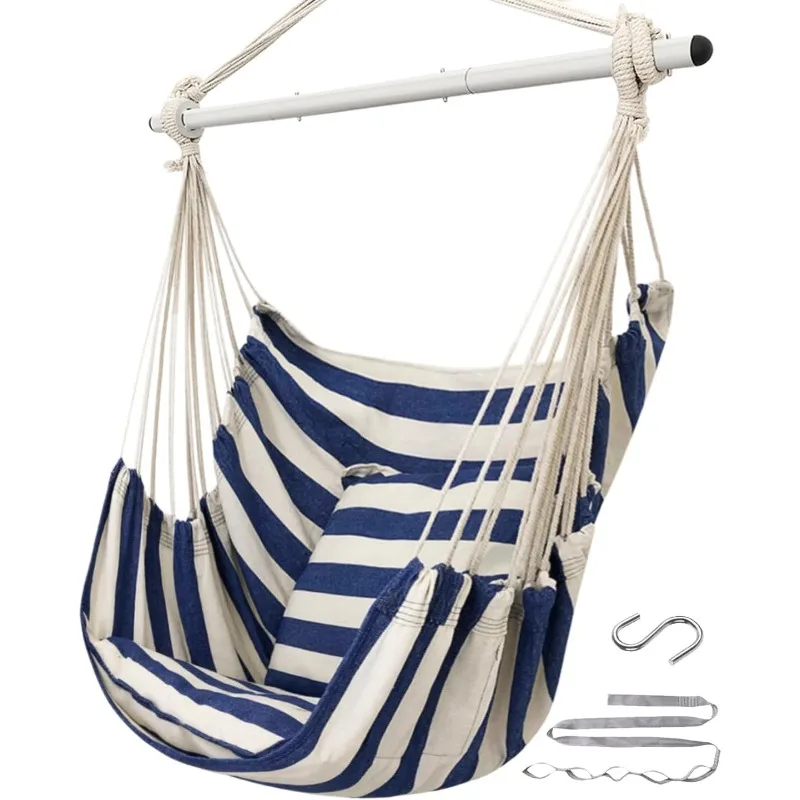
Expert Tips for Maximum Comfort in Any Hammock
Whether you choose a spreader bar or gathered end design, these expert tips will help you achieve the most comfortable experience possible:
Perfect Your Hang Angle – For gathered end hammocks, hang with approximately 30° angle from horizontal on the suspension lines. For spreader bars, ensure the fabric is taut but not drum-tight, with a slight curve in the middle.
Find Your Ideal Height – The optimal hammock height places the lowest point about 18-24 inches (45-60 cm) off the ground when weighted. This allows easy entry/exit while providing proper clearance.
Master the Diagonal Lay – In gathered end hammocks, position your body at a 30-45° angle from centerline to create a flatter, more ergonomic surface. In spreader bar hammocks, slight diagonal positioning can still improve comfort.
Use Proper Suspension Distance – Gathered ends function best with anchor points 10-15 feet apart. Spreader bars typically require 12-15 feet for proper tension. Adjustable suspension systems make fine-tuning easier.
Consider a Structural Ridgeline – For gathered end hammocks, a non-stretching ridgeline (cord running above the hammock between ends) maintains consistent sag regardless of how tightly you hang the suspension.
Protect Against Cold Spots – Any compressed insulation (sleeping bags/pads) loses effectiveness under your body weight. Use underquilts or specialized hammock pads that wrap around your sides.
Embrace Proper Entry Techniques – For spreader bars, sit in the center first before reclining. For gathered ends, sit on the edge, spread the fabric with your hands, then swing your legs in before reclining.
For a comprehensive understanding of spreader bar designs, our guide on mastering the oasis: ultimate guide to spreader bar hammocks frames offers detailed setup and optimization techniques.
Can You Sleep Overnight in Both Hammock Types?
Many users wonder which hammock style better suits overnight sleeping. While both can work, they offer distinctly different sleeping experiences.
Gathered end hammocks generally excel for overnight sleeping because:
– The cocoon effect creates a secure feeling that prevents rolling during sleep
– The diagonal lay position supports proper spinal alignment
– They’re compatible with comprehensive sleep systems (underquilts, top quilts, bug protection)
– Their stability reduces the chance of nighttime accidents
Spreader bar hammocks can work for overnight sleeping with some adaptations:
– A slight sag (rather than completely flat tension) improves sleeping comfort
– Side sleeping becomes possible with proper pillow arrangement
– Stomach sleeping is feasible for those who prefer it (nearly impossible in gathered ends)
– Sleeping pads must be secured to prevent shifting during the night
For stomach sleepers, spreader bar hammocks are the only viable option. Back sleepers typically find gathered end hammocks more comfortable when properly positioned diagonally. Side sleepers can adapt to either style with proper accessories and positioning.
Are Spreader Bar Hammocks Really Less Stable?
While spreader bar hammocks do have a reputation for being less stable, this characteristic can be managed with proper setup and usage techniques.
The physics behind the stability difference is straightforward:
– Spreader bars raise the center of gravity above the suspension points
– The rigid bars prevent the natural self-centering that occurs in gathered designs
– The flatter surface allows more lateral movement of body weight
However, these stability concerns can be minimized by:
– Setting the optimal height (lower is generally more stable)
– Ensuring even tension across the hammock surface
– Using wider spreader bars for improved stability
– Entering from the center rather than the sides
– Adding stabilizing cords to limit unwanted movement
Children and pets can use spreader bar hammocks safely with proper supervision and by following these stability enhancement techniques. Many users find that after a brief adjustment period, they develop the intuitive movements needed to maintain stability in these hammocks.
For environments where multiple users of varying experience levels will use the hammock, gathered end designs do offer a more forgiving learning curve and inherently greater stability.

